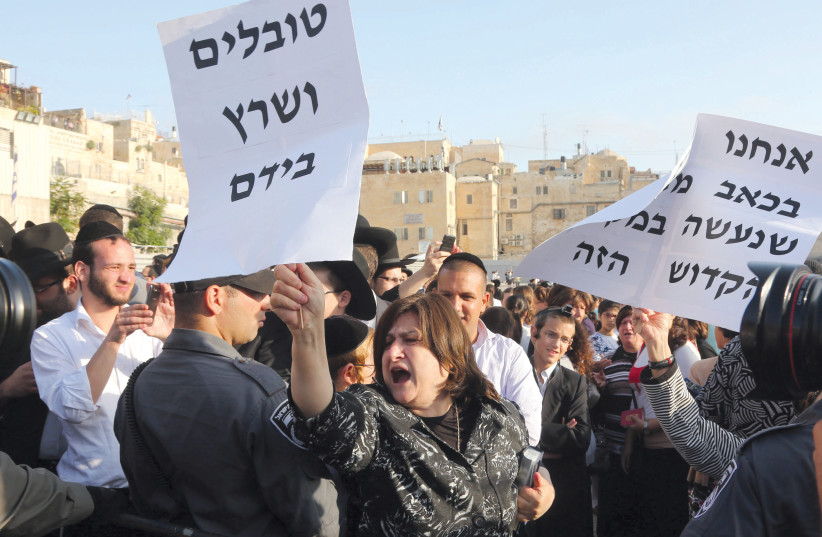Men and boys celebrate life cycle events (bar mitzvas, upcoming marriages) on the men’s side of the Western Wall; celebrations on the women’s side are rare. Original Women of the Wall expects that to change as its continued presence normalizes women’s group tefilah (prayer) with tallit and tefillin at the choice of each women and Torah reading when appropriate.
While some consider women’s group prayer proscribed in Jewish law, Original Women of the Wall demonstrates that with respect and tolerance, all Jewish women can practice according to their custom at this and all sites.
The Western Wall, known in Hebrew as the Kotel, is the only surviving remnant of the holy Temple built in Jerusalem as the center for Jewish worship. After thousands of years when this site was controlled by others, since 1967 Jews have returned to pray there. Prominent visitors to Israel – Jews and non-Jews alike – are brought to the Kotel. National events, army inductions are conducted at the Western Wall.
In the fall of 1988, a group of women participating in an academic conference in Jerusalem, inspired by Rivka Haut, an Orthodox teacher of Talmud and Midrash, went to the Kotel to pray together. The group was multi-denominational. Participants described it as an emotional and inspirational experience.
Subsequently, some of the women who lived in Jerusalem decided to continue to pray at the Wall. Eventually, under the leadership of Bonna Devora Haberman, a group evolved known as Women of the Wall. Haut and other women who had returned to North America formed an organization known as the International Committee for Women of the Wall (ICWOW). Women of the Wall, known in Hebrew as Nashot Hakotel, organized into a nonprofit group with stated goals of conducting women’s prayer at the women’s section of the Wall and providing education toward that end. As it had been at the first service, women from all denominations participated. This joining together of various traditions, rare in Jewish practice then and now, was one of the striking characteristics of the group.

Over the 34 years of its existence, Women of the Wall maintained its multi-denominational character, ranging at times from barely a minyan of women [10 worshipers] to hundreds of participants. The group prays at the beginning of every lunar month, Rosh Hodesh, which in Jewish tradition is a day associated with women. The reaction of the Israeli public has ranged from lack of awareness to surprise to pleased responses and, unfortunately, to occasional indignation, sometimes resulting in insults or physical objects hurled at the women as they pray. At times, the police have detained members of Women of the Wall for the offense of “disturbing the public order.” Judges have informed the police that women have the right to pray just as men do, and detentions have ceased in recent years. The most recent case heard in Judge Moshe Sobel’s appellate court in 2013 confirmed not only women’s right to pray at the Kotel but to pray “according to their custom.” Justice Sobel stated that they had become part of the minhag hamakom – the practice of the place.
The splitting of Women of the Wall over Robinson's Arch, egalitarian prayer
Nine years ago, contravening the goals stated in their group’s charter and without consulting ICWOW or other longtime supporters and members of the organization, board members of Women of the Wall agreed to enter into negotiations with the government to abandon the Kotel and move their prayer to the archaeological site located south of the traditional Wall, known as Robinson’s Arch.
Immediately upon hearing of this decision, Haut, Haberman and others took the name Original Women of the Wall. The name is not only in recognition of Haut, Haberman and most other founders of the group joining together, but also a statement of unshakable commitment to the original goals of the group with the original vision of including all women of all denominations.
Supporters feared that despite the acknowledgment, recognition and acceptance by rabbis of all denominations, Israeli courts, Israeli and worldwide public opinion, the status of women praying at the Kotel would regress. Original Women of the Wall took up the challenge of meeting monthly (on days other than Rosh Hodesh) to establish that women’s prayer at the Kotel would continue regardless of any agreements made by others. It should be noted that Robinson’s Arch is a site that is open for egalitarian prayer. There is no need to negotiate for a site that exists. Orthodox members of Women of the Wall cannot be comfortable in an egalitarian setting, and in solidarity Original Women of the Wall is committed to the original goals of the group,
The group is small as Women of the Wall was years ago. The members rarely encounter any harassment or disturbance. Their prayer has been described as inspirational. The group remains committed to multi-denominationalism, a characteristic too often lacking in Israeli society and in Jewish prayer in general. Twice the group has celebrated an upcoming marriage, with the bride given the honor of reading from the Torah scroll. One member recalls a haredi woman approaching the group during Torah reading apparently to complain; but upon seeing the open scroll, she physically hung on to the Sefer Torah because she had clearly never had a chance to be so close to one, let alone touch one or read from it.
Members of the group have brought a lawsuit before the Supreme Court of Israel petitioning that the rights of women to read from a Torah scroll at the Kotel be recognized and enforced. The case has moved slowly, but Original Women of the Wall patiently awaits justice in this and all matters.
The writer, who resides in Jerusalem, is a founding member of Original Women of the Wall and former board member of Nashot HaKotel.
